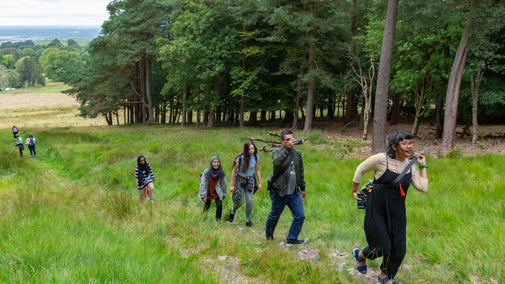Bookham Common butterfly walk
Surrey
This walk takes you through one of the best woods in England for sighting the elusive purple emperor butterfly. Purple emperors are Britain's second largest butterfly, with a wingspan of over 8cm. It was first recorded here on 11 June 2017, at the earliest point in more than 120 years, following balmy temperatures in the spring. The species now thrives here thanks to decades of work by National Trust rangers to protect the specialist habitats it needs.
Near to
Bookham CommonsStart point
Tunnel Car Park, grid ref: TQ130557Trail information
Spot a variety of butterflies and many birds in the woodland
The purple emperor season begins in late June and peaks in the second week of July. From noon to early evening, the males can be seen at the Mark Oak and Hill Farm 'master trees'. By August the butterflies are mostly gone.
More near here
Bookham Commons activity trail
Explore Bookham Commons with this easy stroll through the woods

Get in touch
Church Road, Great Bookham, Surrey, Nearest postcode KT23 3LT
Our partners

We’ve partnered with Cotswold Outdoor to help everyone make the most of their time outdoors in the places we care for.
You might also be interested in
Walking
Explore some of the finest landscapes in our care on coastal paths, accessible trails, woodland walks and everything in between. Find the best places to walk near you.

Things to see and do at Bookham Commons
Tranquil ponds, woodland glades and open grassland offer places to play, picnic and spot a range of wildlife. And there are dedicated running, cycling and horse riding tracks too.

History of Bookham Commons
The commons were home to Stone Age man and Saxon monks, were plundered by Henry VIII and visited by the Victorians, saw wartime action and were saved with help from local people.

Butterflies at Bookham Commons
Bookham Commons is home to some important and rare butterfly species such as the purple emperor, white admiral and silver-washed fritillary.

Walking in Surrey
From hilltop hikes with some of the finest views of the Surrey Hills to gentle wanders through ancient woodlands, these are some of the best walks in Surrey.

Staying safe at National Trust places
The special places in National Trust care sometimes come with a few risks for visitors, be it coastline or countryside. Find out how to keep safe throughout your visits.

Follow the Countryside Code
Help to look after National Trust places by observing a few simple guidelines during your visit and following the Countryside Code.

Cotswold Outdoor: our exclusive walking partner
Learn about the National Trust’s ongoing partnership with Cotswold Outdoor. Find out how they help us care for precious places and the exclusive discount available for National Trust supporters.

